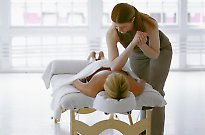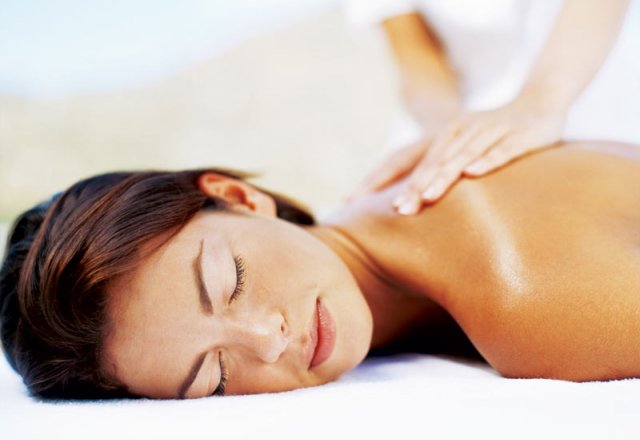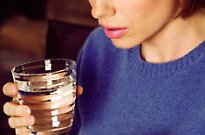
The A to Z of massage therapies

Liz Nowosad explains different massage techniques with this easy A to Z guide to massage
With over 80 different types of massage, it’s easy to be confused as to which form is best for you.
Acupressure
Acupressure is a technique of TCM (traditional Chinese medicine) often described as ‘acupuncture without needles’. In an acupressure session, the therapist applies deep finger pressure to certain points that follow the energy channels of the body’s meridian lines. Acupressure encompasses the whole person including body, emotions, mind and spirit.
- GOOD FOR circulation, energy and relief from pain, stress and tension.
Bowen Therapy
This form of therapy is a gentle, holistic and multi-dimensional approach that empowers the body to heal itself. Rolling movements over muscles, tendons and ligaments are applied to disturb the fascia, and frequent pauses are incorporated to give the body time to benefit from the treatment.
- GOOD FOR acute and chronic pain, fibromyalgia, shoulder pain, sciatica, chronic fatigue, neck pain, autism, multiple sclerosis, stress, trauma, depression and sporting injuries.
Cupping
Used to expel toxins from areas of pain and tightness, cupping involves placing glass cups on the body, which are held in place by a suction force. The cupping action on the nervous system can be sedating, inducing a deep state of relaxation. After treatment, a feeling of lightness and flexibility in the area that was causing pain or restriction can be achieved.
- GOOD FOR relaxation, pain relief, fibromylagia, anxiety, insomnia, chronic pain, sciatica and asthma.
Deep Tissue massage
Deep finger pressure and slow movements are used to break down scar tissue and compacted muscle fibres to release toxins and ease tension and pain.
- GOOD FOR detoxification, pain and tension relief.
Essential Oils for aromatherapy massage
Oils with specific healing properties – including those that aid in relaxation, rejuvenation and invigoration, are used to soothe, heal and energise the body. The oils are both inhaled during the treatment and absorbed through the skin.
- GOOD FOR relieving stress, boosting mood and increasing energy levels, depending on the oil used for treatment.
Feldenkrais
A trained practitioner uses his or her hands to guide the movement of a single client, who may be sitting, lying or standing (fully clothed). The practitioner uses this hands-on technique to help you experience the connections among various parts of the body (with or without movement). Through precision of touch and movement, you can learn how to decrease excess muscle movement and pressure and thus move more freely and easily.
- GOOD FOR posture, flexibility, coordination, self-image and for alleviating chronic muscular tension and pain.
Gua sha
An instrument (such as a Chinese soup spoon or jar lid) is ‘drawn’ or pressed across the skin where an injury or imbalance is and a distinctive reddening of the skin known as “Sha” can be observed. This reddening is said to be a good response and brings immediate and lasting benefits that include a reduction in inflammation, tightness and pain from the superficial and deeper layers of the body. The instrument is used as according to this technique the hands alone may not be enough to dispel heat, increase oxygen in the area and stimulate blood flow in the way that the Gua Sha can. The treatment is used for the head down, starting at the neck before going to the chest, back, shoulders and arms, legs, and down to the ankles.
- GOOD FOR muscle aches and pains, heatstroke, sunstroke, dizziness and chills.
Hot stones
Using smooth, flat and heated stones, a hot stone massage therapist will place stones along your spine and other key points on the body including the palms of your hands, your belly and between your toes to target muscle tension and to stimulate circulation and the flow of energy through the body. The therapist may also use oil-coated stones to perform various massaging strokes on the body, which will apply pressure on affected areas to ease muscle tension and stiffness.
- GOOD FOR chronic muscular tension and pain, muscle aches, relaxation and for treating poor circulation.
Indonesian massage
This deep massage uses the thumbs to penetrate deep into the muscles and soft tissue. The oil used in Indonesian massage has a beneficial effect on the body’s circulation and lymphatic system by releasing its regenerative and self-healing powers.
- GOOD FOR breaking down tensely knotted tissue, treating injury, relaxation, and rejuvenation.
Jin Shin Do
Meaning ‘the way of the compassionate spirit’, this is a modern day synthesis of acupressure, Qi Gong exercises, psychology and therapeutic massage. Jin Shin Do uses physical pressure, combined with energy work and techniques from Ericksonian psychotherapy. The idea behind Jin Shin Do is to help the patient realise an open flow of an energetic life force, based on the Chinese idea of qi.
- GOOD FOR flow of qi or life force in the body, relieving muscle tension, relieving neck, shoulder and back tension and pain, alleviating symptoms related to joint problems, arthritis, fatigue, digestive difficulties, chest and respiratory difficulties and for treating headaches, migraines and insomnia.
Kahuna/Hawaiin Lomi Lomi
The word ‘Kahuna’ has many meanings, the most frequent definition being loving hands. It is a relaxing, deep and rhythmical massage that works gently but deeply into the muscles using continuous flowing strokes. The practitioner uses the forearm, fingers, heel and palm of the hand in long, flowing movements over the body, which bring fresh oxygen to every cell. Acupressure points may also be used, in addition to warm stone therapy, breathing techniques, chanting, music, visualisations, herbs and aromas, depending on the lineage of the practitioner. A main principle of Kahuna is to encourage clients to know themselves better by inwardly listening to their own bodies and experiences. It aims to help clients accept their own body and love themselves.
- GOOD FOR relaxation, circulation, improving self-worth and increasing the vibrational rate of the cells.
Lymphatic drainage
Gentle touch and rhythmical movements are used in this massage technique to improve the flow of lymph (colourless fluid that surrounds the tissues and circulates via lymph vessels). It is a gentle, whole-body treatment that relaxes the nervous system and aids the body’s immune system.
- GOOD FOR detoxification, asthma, eczema, acne, sinus problems, congestion and post-operative healing.
Myotherapy
Myotheraphy covers a variety of treatment modalities, which include soft tissue treatment, trigger point therapy, myofascial dry needling, thermal therapy, electrical stimulations and corrective exercises, to assist in pain management.
- GOOD FOR sporting and occupational injuries, stiffness and pain associated with poor posture, acute and chronic conditions affecting function and mobility, scoliosis/kyphosis, headaches/migraines and chronic overuse syndromes including tendonitis, RSI, tennis/golfer’s elbow, arthritis and Multiple Sclerosis.
Neuromuscular therapy
This technique involves applying concentrated thumb and finger pressure to trigger certain points on the body (tender points that have become sensitive due to lack of nutrient and blood flow in the body). This approach to pain relief helps to balance the musculoskeletal system (skeleton and muscles of the body) and the nervous system (brain, spinal chord and nerves).
- GOOD FOR pain-relief, flexibility, circulation, postural problems, detoxification and for increasing energy.
Oriental massage/Shiatsu
Shiatsu means ‘finger pressure’ and is a Japanese therapy that combines massage, stretching and gentle physical pressure along meridian channels and pressure points. When the meridians are balanced, the tissues, muscles, nerves, metabolism and emotions are also balanced.
- GOOD FOR back pain, stress, headaches, whiplash, neck stiffness, joint pain and sports injuries.
Pregnancy massage
Gentle massage techniques to improve blood flow and reduce pregnancy discomfort.
- GOOD FOR reducing any discomfort in pregnancy, stress relief, relaxation.
Rolfing
This technique is based on the belief that a combination of physical and emotional trauma stored in the muscles and connective tissue is responsible for many physical and psychological problems. It is often conducted as a series of 10 sessions, consisting of precise and strategic work to loosen and stretch the connective tissue to realign the body, combined with subtle movements and postural education.
- GOOD FOR realignment and posture, which incidentally deal with a myriad of other musculoskeletal problems.
Swedish Massage
The strokes and movements in Swedish massage are each conceived as having a specific therapeutic benefit. One of the primary goals is to shorten the recovery time from muscular strain by flushing the tissue of lactic acid, uric acid and other metabolic wastes.
- GOOD FOR circulation, flexibility, recovery from muscular injury, relaxation, detoxification, emotional and physical stress relief.
Tui Na
Guided by the TCM pillars of Wu Xing (five elements), Yin and Yang and Jing Luo (the meridian system), this is a deeply relaxing treatment incorporating acupressure to bring the body into balance. The treatment focuses on achieving a more harmonious qi (energy flow) through the body to encourage natural healing. Traditional hand techniques massage the soft tissue, acupressure techniques enhance qi and manipulation techniques realign the muscles and ligaments.
- GOOD FOR relaxation and management of pain and injury.
Usui Reiki
This is an ancient Japanese treatment that can incorporate other alternative healing methods, such as chakra balancing, meditation, crystals, aromatherapy and spiritual healing. Hands can be placed on or just above the client in a passive way and the energy from the universe is transferred through the practitioner to the client.
- GOOD FOR emotional balance, spiritual awareness and to increase positive energy.
Watsu
Watsu (Water Shiatsu) is the process of floating in a pool of warm water (supported by floats), while the practitioner applies stretches and principles of Zen Shiatsu. Stretching opens energy channels and strengthens muscles to improve flexibility and the warm water nurtures and relaxes the body while providing support to take weight off the spine.
- GOOD FOR flexibility, relaxation, relieving a rigid spine and releasing pinched nerves.
Yoga massage
A dynamic bodywork therapy based on yoga and Ayurveda – also known as Nuad Boran and widely known as traditional Thai massage – yoga massage sees the practitioner guiding the recipient through a series of yoga postures while palming and thumbing along the body’s energy Sen lines and pressure points. Thai Yoga Massage is performed on a mat on the floor, with both the client and practitioner dressed in comfortable clothing, allowing ease of movement and flexibility. No oils or creams are used.
- GOOD FOR muscular tension, circulation, boosting immune system and balancing the body energetically.
Zen Shiatsu
Zen Shiatsu is a hands-on therapy that uses traditional oriental diagnosis and supportive acupressure to balance the energy pathways of the body. It is a holistic therapy designed to uplift and harmonise physical, emotional, mental, and spiritual wellbeing. By working along the meridians (energy pathways) of the body, touching on specific acupressure points and rebalancing energy, Zen Shiatsu creates a feeling of deep relaxation as well as renewed vitality.
- GOOD FOR fatigue, insomnia, tension, depression, fertility, libido, asthma, lower back pain and stress.


